

Anyone who watched an Arkansas game last year most likely witnessed the Wildcat offense in action.
Darren McFadden would line up at quarterback in a modified shotgun formation, a receiver would come in motion, and they would run any number of plays that involved snapping the ball directly to either McFadden or the motion back, and then running, passing, or both.

Although somewhat gimmicky, the Wildcat proved to be a major part of Arkansas’ offense, and was largely responsible for the Razorback’s remaining competitive in the murderous SEC.
However, the success of the formation was largely predicated upon having one of the greatest playmakers in college football history at their disposal. Not only was McFadden a specimen as a running back, but he also played quarterback in high school and therefore had enough throwing ability to warrant putting him at that position in the formation.
NCAA Football ’08 included the Wildcat formation in Arkansas’s playbook, and appropriately did justice to McFadden’s throwing ratings. The result was that in the game, like in real life, people could run the formation and experience the luxury of getting the ball directly into their playmaker’s hands.
In this year’s NCAA, the Wildcat is missing from Arkansas’s playbook, but thankfully it has been preserved. It can be found in the Indiana, Ole Miss, and Tulsa playbooks. With the right personnel decisions, and a little practice, you too can successfully run the Wildcat formation with your own team.
The first step is to use one of the aforementioned playbooks when the time comes to select your team. I have Ole Miss’s playbook set as my default, since I feel it has a nice balance of Shotgun, Ace, and I-formation plays (not to mention the Wildcat).
Once you have your playbook picked, you have another decision to make. Depending on your quarterback’s mobility, you may want to consider substituting another player (like your HB) at QB in the Wildcat formation. To do this, move the right stick to the right once inside the Wildcat formation on the play calling screen. At the top of the screen, where it shows the formation subs, you should see an option to substitute your HB with your QB. This will put your starting halfback at quarterback, and ensure you have someone fast in position to get the ball.
Next, you need to understand how to read the play diagrams before you. There are only 8 plays in the formation, so it shouldn’t take long for one to learn how to run each one.
Let’s start with a basic play: Jet Sweep
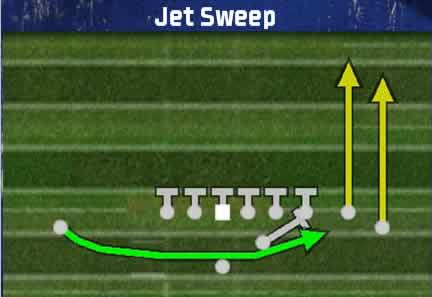
The first thing to notice is every play in the formation has the left wingback coming in motion as indicated by the green line. The play is always going to be timed so that the ball is snapped when the motion back is directly in line with the QB/HB.
This ensures that the defense, despite knowing exactly when the ball is going to be snapped, still has no idea who is going to get it. In Jet Sweep, the ball is snapped to the quarterback who hands it off to the motion back. The motion back just keeps running with the ball to the outside edge, and never misses a beat.
This is one of the simplest Wildcat plays, and a great play to start with when you reveal your formation – getting the defense to think about the possibility of you handing off the ball.
If the ball does not go directly to the motion back, then there are still a few ways the play can develop. The diagrams below show Power Fk Jet and Wrap Fk Jet – two basic QB/HB run plays in the formation.

Video

As you can see, these two plays are just runs to the left or right, but by balancing them you can maintain a steady run game without breaking from the formation. Remember, the wideout is still going to come in motion, only the ball will be snapped directly to the quarterback and you can take off running to the appropriate side.
I have my audibles set up with both of these plays, so I can easily switch from one to the other if I sense one side of the defense will be more porous than the other. Again, these are great plays for keeping the defense off-balance.
Keep in mind, the Wildcat’s strength is the versatility it affords, and PA Jet Sweep is a play that allows for the biggest exploitation of that versatility.
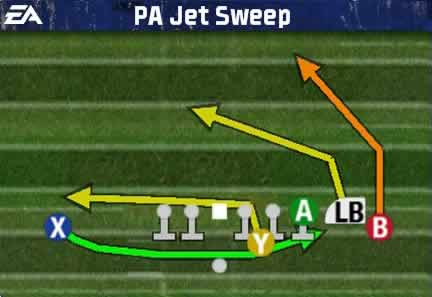
This play is great because it gets the defense going the wrong way with a fake handoff to the motion back, then boots the QB/HB out to the open side while also bringing receivers at three levels across to that same side.
More often than not the boot side is wide open to scramble – especially if the defense is in man coverage. Even if the defense is playing zone, you still have three receiving options to work with. Two of those receivers will also be close enough so even a regular old HB with no throwing advantage will still be able to make the toss if necessary.
This is probably my favorite play in the game because of all the options it leaves, and I highly recommend running it a bunch of times to get a feel for how it unfolds. Once you understand how to make this play work, I guarantee you’ll go back to it over and over again. Just don’t get caught with your hand in the cookie jar.
The Sweep QB Screen and the WR Screen are two more advanced plays that have both a higher risk and higher reward.
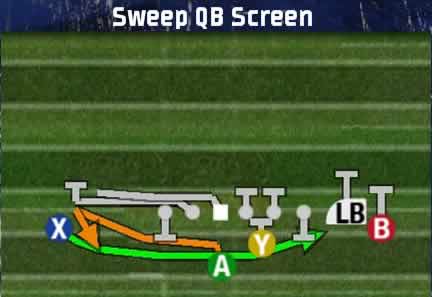
Video
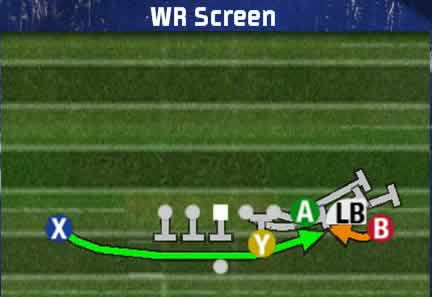
The WR Screen is a simple screen pass, with the motion back as an extra blocker for the player receiving the pass. Remember to wait an extra second with the ball to let the blockers set up, and then fire it in to your WR.
Follow your blockers and you should be able to find some empty space and hopefully make a big play.
The Sweep QB Screen is a tricky little play where the ball gets handed off to the motion back, who then throws it back to the quarterback. This play works really well if the defense brings any pressure, but is also susceptible to a major loss of yardage under those same circumstances.
Basically, the closer your motion back comes to getting tackled behind the line, the more successful this play will be. The key is not to jump the gun on throwing the ball back to your QB, but to instead wait until he disengages and hits the flat. The QB (in this case the receiver) will most likely have all the space in the world once he gets the ball, so hang in as long as you can and then just tap A to have the motionback lob the ball out the open space and take off for the races. Again, practice mode is the best place to learn how to make this play work.
The last two plays, Jet Sweep Pass and WR Double Pass, have proven in my experience to be the weakest in the package.
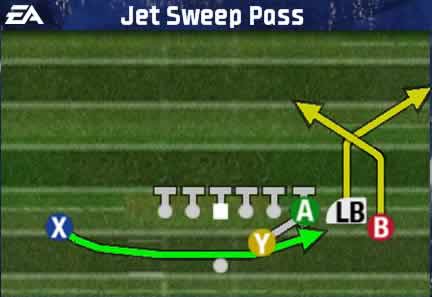
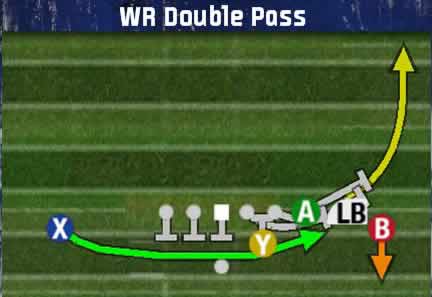
Jet Sweep Pass hands the ball off to the motion back who then has two downfield passing targets to throw to.
The problem is that your WR most likely does not have the arm attributes to make the throws in the play – often resulting in an interception. Only run it if you happen to have a thrower at wing back, or if you plan to scramble.
WR Double Pass is similar to the Sweep QB Screen except the QB gets the snap and the first pass is a screen to the wideout. The second pass is downfield instead of back across the field. Again, this is an interception waiting to happen, although at least with this play there is a greater likelihood of a receiver being so wide open he can’t be missed.
If the defense bites on the screen and the downfield receiver is uncovered, try lobbing the ball down field and see what happens. If the D plays on the pass at all, just scramble down the field and try to salvage as many yards as you can.
Once you get a feel for each of these plays, you can start stringing them together to develop a solid offensive strategy. I don’t recommend running the Wildcat exclusively, but it can definitely suffice over the course of an entire drive or more.
As I mentioned earlier, I have my audibles set up with Wildcat plays so I can bounce from one to the other depending on what I see in the defense. This can make for a devastating no huddle attack, and allows you to really think ahead of your opponent.
Once you master the Wildcat, it is a very rewarding experience. If you convert, you’ll find yourself building your offense around the strategy, and recruiting mobile quarterbacks and speedy halfbacks to try substituting into the formation.




 OS Tip of the Day: Never Waste Time in SSX
OS Tip of the Day: Never Waste Time in SSX UFC Undisputed 3: Basic Tips
UFC Undisputed 3: Basic Tips Besting The Jordan Challenge (Part 1)
Besting The Jordan Challenge (Part 1) OS Tip of the Day: Use Your Farm System in the Show
OS Tip of the Day: Use Your Farm System in the Show OS Tip of the Day: Be Situationally Aware
OS Tip of the Day: Be Situationally Aware